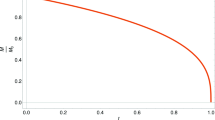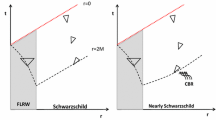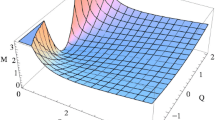Abstract
The analysis of black holes fed by the omnipresent Cosmic Microwave Background Radiation (CMBR) constitutes benchmark cases. The rate of energy and entropy variation of a Schwarzschild black hole fed by CMBR is analytically obtained. The entropy analysis revealed that there is a higher value of black hole’s critical mass than that obtained from an energy analysis, which is needed for its existence with high probability. At this minimum value of mass of the Schwarzschild black hole, the entropy generated due to its existence becomes positive. The black hole’s negentropy and the difference between its exit and inlet specific entropies are shown to more importantly correlate with its event horizon area than the black hole’s entropy.









Similar content being viewed by others
References
S.W. Hawking, Black-hole explosions. Nature 248(5443), 30–31 (1974)
S.W. Hawking, Particle creation by black holes. Commun. Math. Phys. 43(3), 199–220 (1975)
P.C.W. Davies, S.A. Fulling, W.G. Unruh, Energy–momentum tensor near evaporating black-hole. Phys. Rev. D 13(10), 2720–2723 (1976)
W.G. Unruh, Experimental black-hole evaporation. Phys. Rev. Lett. 46(21), 1351–1353 (1981)
R. Schützhold, W.G. Unruh, Gravity wave analogues of black holes. Phys. Rev. D 66(4), 044019 (2002)
S. Weinfurtner, E.W. Tedford, M.C.J. Penrice, W.G. Unruh, G.A. Lawrence, Measurement of stimulated Hawking emission in an analogue system. Phys. Rev. Lett. 106(2), 021302 (2011)
S. Gao, R.M. Wald, “Physical process version” of the first law and the generalized second law for charged and rotating black holes. Phys. Rev. D 64(8), 084020 (2001)
J.D. Bekenstein, How does the entropy/information bound work? Found. Phys. 35(11), 1805–1823 (2005)
L. Susskind, The world as a hologram. J. Math. Phys. 36(11), 6377–6396 (1995)
T. Jacobson, Thermodynamics of spacetime: the Einstein equation of state. Phys. Rev. Lett. 75(7), 1260–1263 (1995)
F. Hammad, Thermodynamics of black holes from an entropy functional: an other approach using generalized elasticity. Int. J. Theor. Phys. 49(5), 1055–1064 (2010)
P. Mitra, Area law for black hole entropy in the SU(2) quantum geometry approach. Phys. Rev. D 85(1), 104025 (2012)
H. Chung, Hawking radiation and entropy from horizon degrees of freedom. Nucl. Phys. B 858(2), 214–231 (2012)
F. Porcelli, G. Scibona, On the black hole’s thermodynamics and the entropic origin of gravity. Eur. Phys. J. Plus 127(1), 1 (2012)
J.D. Bekenstein, Black holes and information theory. Contemp. Phys. 45(1), 31–43 (2003)
M. Rabinowitz, Black hole radiation and volume statistical entropy. Int. J. Theor. Phys. 45(5), 877–884 (2006)
J.M. Bardeen, B. Carter, S.W. Hawking, The four laws of black hole mechanics. Commun. Math. Phys. 31(2), 161–170 (1973)
G.W. Gibbons, M.J. Perry, Black holes and thermal Green functions. Proc. R. Soc., Math. Phys. Eng. Sci. 358(1695), 467–494 (1978)
H. Saida, The generalized second law and the black hole evaporation in an empty space as a nonequilibrium process. Class. Quantum Gravity 23(22), 6227–6243 (2006)
H. Saida, Black hole evaporation in a heat bath as a nonequilibrium process and its final fate. Class. Quantum Gravity 24(3), 691–722 (2007)
A.A. Penzias, R.W. Wilson, A measurement of excess antenna temperature at 4080 Mc/s. Astrophys. J. 142(1), 419–421 (1965)
T. Hatano, S.-i. Sasa, Steady-state thermodynamics of Langevin systems. Phys. Rev. Lett. 86(16), 3463–3466 (2001)
S.P. Mahulikar, H. Herwig, Exact solution for energy analysis of Schwarzschild black-hole fed by CMBR. Astrophys. Space Sci. 341(2), 417–420 (2012)
H. Saida, Two-temperature steady-state thermodynamics for a radiation field. Physica A: Stat. Mech. Appl. 356(2–4), 481–508 (2005)
M. Rabinowitz, Little black holes: dark matter and ball lightning. Astrophys. Space Sci. 262(4), 391–410 (1999)
D.J. Fixsen, The temperature of the cosmic microwave background. Astrophys. J. 707(2), 916–920 (2009)
S. Frautschi, Entropy in an expanding universe. Science 217(4560), 593–599 (1982)
S.A. Balbus, Enhanced angular momentum transport in accretion disks. Annu. Rev. Astron. Astrophys. 41, 555–597 (2003)
W.H. Zurek, Entropy evaporated by a black hole. Phys. Rev. Lett. 49(23), 1683–1686 (1982)
J.D. Bekenstein, Generalized second law of thermodynamics in black-hole physics. Phys. Rev. D 9(12), 3292–3300 (1974)
A. Ore, Entropy of radiation. Phys. Rev. 98(5), 887–888 (1955)
R. Swenson, Emergent attractors and the law of maximum-entropy production: foundations to a theory of general evolution. Syst. Res. Behav. Sci. 6(3), 187–197 (1989)
D.J. Evans, D.J. Searles, Equilibrium microstates which generate second law violating steady states. Phys. Rev. E 50(2), 1645–1648 (1994)
S.P. Mahulikar, H. Herwig, Exact thermodynamic principles for dynamic order existence and evolution in chaos. Chaos Solitons Fractals 41(4), 1939–1948 (2009)
Acknowledgement
The authors thank the German Research Foundation’s (DFG) Mercator Professorship programme for sponsoring this investigation.
Author information
Authors and Affiliations
Corresponding author
Rights and permissions
About this article
Cite this article
Mahulikar, S.P., Herwig, H. Thermodynamic analysis of a Schwarzschild black hole fed by cosmic microwave background radiation. Eur. Phys. J. C 73, 2292 (2013). https://doi.org/10.1140/epjc/s10052-013-2292-2
Received:
Published:
DOI: https://doi.org/10.1140/epjc/s10052-013-2292-2




